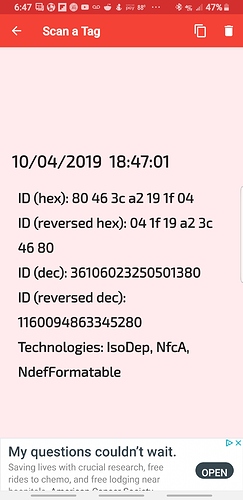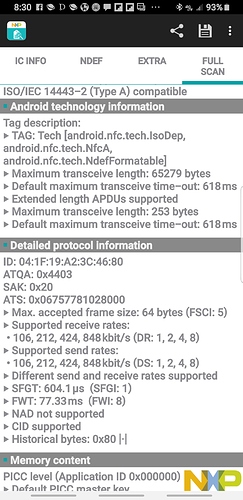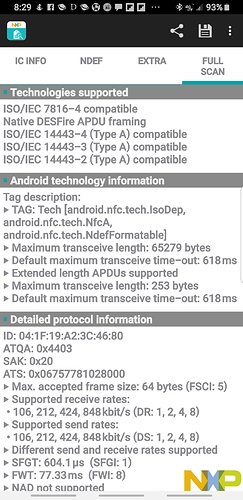Looking to pull the trigger on this upgrading my self thing. I have a key card that I use to get through doors and I’m sometimes forgetful and cant keep up with it.
This and about 1000 other things are what I’m looking to get done with these implants. I saw one of the implants was $1000. What’s the difference between the cyborg package and this one. I looking to get as much as possible done. What are my options?
Hey LTDB,
The VivoKey Flex One is listed as $1000, but that is just a placeholder because the product is still in a private beta testing phase. The final cost will likely be much lower.
As for what you can get done, there are many options. Since you’re interested in that keycard you use for access control, I’d recommend you start by figuring out what frequency it is operating at. Once you figure out the frequency you can select an implantable tag that uses that communication protocol.
The two most likely frequencies are 125kHz and 13.56MHz. You can download the NXP TagInfo app for your phone, turn on NFC, and attempt to scan the card to determine if it is 13.56MHz. If it works, you might want to look into the xNT or FlexDF tags. Although you won’t be able to directly clone the card onto your tag, you may be able to enroll the tag into the system that manages your access control and use it in lieu of your card.
If your phone is unable to scan the card, it’s likely operating at 125kHz. If that’s the case, you might want to check out the xEM tag. It has a feature that allows you to use a device to clone some types of access control cards directly onto your implant.
Do people ever get multiple implants to cover different frequencies? But I guess you half to implant them in different locations as to not interfere with reading or writing abilities…?
From my brief search it seems that ISO-DEP cards are NFC Type-4, like the FlexDF implant. They are pretty advanced chips that support application frameworks. Does your card say Visa or MasterCard anywhere on the face. If so you may be boned.
As for multiple implants to address different frequencies, yeah people certainly do that. Install location proximity isn’t usually an issue because 125kHz and 13.56MHz tags don’t really crosstalk so they can be right next to each other. I have two different NFC tags, one in my hand and the other in my forearm. I don’t have issues with reading the"wrong" tag. They would have to be within a few cm for that to be a concern.
That tag is for my work to open doors, but not to clock in to the time clock. We gotta use fingerprint for that.
I’d get multiple implants if that get me more uses.
Unless you have a specific use case in mind, I don’t recommend installing multiple tags over a short period of time. It takes a few weeks for the wound to properly heal, and they’re usually installed in your hands so overlapping recovery times will increase the likelihood of complications and probably suck.
I don’t know how likely it is that you’ll be able to find an implant similar to the access control card from your work, but Amal or someone with the knowledge won’t be able to tell you for sure unless you get more info about the card type. Try that TagInfo app I mentioned and perform a “Full Scan”:
Take a screenshot of the fourth tab. If there’s “memory content” that you’re concerned about then crop it out of the image.
Yep, I also have multiple implants, because manufacturers of RFID access control systems at different office buildings use different frequencies and protocols.
Ok so what can I gather from the scan?
Vicarious what different things do you use the tags for?
All of that information reads exactly like my FlexDF. It may be the same chip. You might be able to use an implant instead of this card for access control, but there are some caveats.
For 13.56MHz cards, you won’t be able to clone your card onto an implant because each chip has a unique ID. That means the best case scenario involves you contacting the admin responsible for your system and asking permission to enroll an implant instead of a card. If the enroll process is managed by an automated kiosk, you could attempt to scan your implant instead of a card when you first sign up. Unfortunately, most of those kiosk systems spit out a brand new card every time, so you can’t really intervene in the process.
Another issue is that if you manage to get an implant enrolled in the system, the implant’s only utility becomes that one thing. The people setting up these access control systems don’t intend the cards to be used for anything else, so their enroll process hogs all the usable space on the card.
I’m not saying this stuff to dissuade you, just to share all the relevant information.
My main use will be at work to unlock doors at work. It’s a person that hands out new key cards, so there might be a way to convince them to apply the info to my chip rather than to my card.
But what other uses can this be applied to? I have a 2015 GMC Sierra so no proximity key there. I have new key pad locks on my house so no use there. I use my Samsung Gear S3 watch to pay for stuff, but would like to upgrade that part of my life.
So one chip with a sole use for work…I understand that. Then could I use another chip to use to pay for stuff like I do with my watch? Could I also use the same chip to open nfc locks I install at home? Like the hidden vent stash. Or one of those cool hidden gun shelfs?
If you enroll a FlexDF in the system at your work, that would be awesome. Please let us know how it goes if you do. The FlexDF has much better read range than the smaller tags in the borosilicate glass because of the antenna size/shape. You shouldn’t have a problem getting it to read if you select a good spot to implant. You can try everything out in the tube it’s delivered in before implantation to make sure it’ll work.
I haven’t tried any commercially available safes that unlock with NFC, but you’ll probably be able to use the one tag for both. My understanding is that many of those systems only check the UID, so the rest of the information on the chip (the stuff for your work swipe) won’t affect their functionality.
Payment is a whole other beast. We’re still working on making that viable with implants. Visa/MasterCard have a stranglehold on payment systems and they aren’t supporting implants. Stay tuned on the progress of the VivoKey system. Maybe Amal will be able to break through.
So which one do I buy and test out for work?
Also i understand how the glass capsule chip is implanted, but how is this flexible one implanted?
Flexible has two proceedures, one with a 4g needle and one with a scalpel. Both are described on the flex series product page.
I have 3 flex chip implants - alle three were implanted with the scalpel methode. I think I would prefer the scalpel.
Installing a Flex tag requires a bit more finesse. I certainly don’t recommend doing it yourself. Check out the Partner Map for assistance.
You should give your artist a heads up that you’re looking to do a Flex install. The process often involves a dermal elevator set and sutures. Do not ask about painkillers over email or the phone before the procedure. The ability to administer anesthetic drugs is limited to licensed professionals in most jurisdictions.




